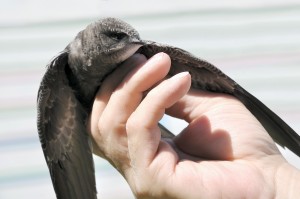During the spring and fall, birds around the country begin their annual migrations for nesting season. One such bird is the chimney swift, which is known for spending its winters in South America before returning north to the United States and Canada for nesting season each summer. While swifts are beautiful to observe, they can cause serious problems for your chimney system.
How to recognize chimney swifts
If you have birds in your chimney, one of the hardest things to do is determining what they are. Luckily, there are several distinguishing characteristics that set chimney swifts apart from other birds.
- Size: Chimney swifts are extremely small birds known for their “cigar shaped” bodies. Swifts also have long, thin, pointed wings.
- Color: Swifts can be a dull gray or brown color. When seen in flight backlit against the sky they may appear black.
- Movement: Chimney swifts are almost always in flight and are rarely seen sitting unless in their nests. They can be identified by their sharp twists and movements in flight.
- Sound: Unlike songbirds, swifts have a distinctive high pitched chirp or call when flying.
I have swifts in my chimney. Now what?
If you wake up to the sounds of birds in your chimney, the first instinct is often to get them out. Unfortunately, chimney swifts cannot be so easily removed. Chimney swifts are one of many bird species protected by the Federal Migratory Birth Treaty Act. This act makes it illegal to remove or destroy chimney swift nests when eggs or hatchlings are present. Because of this, if a family of swifts finds their way into your chimney, there is nothing to do but wait for the young to leave the nest in approximately six weeks.
Why it’s important to keep chimney swifts out
Some homeowners, especially wildlife lovers or those who infrequently use their fireplaces, may not have a problem with chimney swifts nesting in their chimney. While its admirable to allow chimney swifts to nest in your chimney, it is not recommended and should be avoided if possible.
The first reason why you want to keep swifts out of your chimney is because they can cover disease. Migratory birds, including chimney swifts, can spread disease because “their ability to travel over long distances and through a variety of habitats exposes them to a wide range of microorganisms.” Likewise, the presence of nesting materials in the chimney structure often attracts a variety of bugs and insects which can also increase your risk of exposure to disease.
In addition to potentially bringing disease, chimney swifts can be a long-term problem. Like most migratory birds, chimney swifts prefer to return to the same nesting ground every year. This means that if your chimney is left uncapped or open to them they will continue to return and nest in your chimney each season. A new chimney cap or top mounted damper can keep swifts from returning even if they’ve nested in your chimney before.
While chimney swifts are a nuisance, they cannot be removed as easily as other animals. Because of this, it’s important to keep them from getting in to begin with. If you have had swifts in your chimney in the past or think you might currently have a swift nest, contact Jack Pixley Sweeps today!

